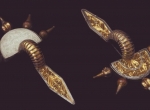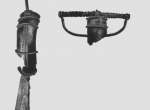Świelino
Świelino, Koszalin district, West Pomeranian Voivodeship (German Schwellin, Kr. Köslin), the hoard was discovered under a great boulder in 1904 during the construction of a railway line. It consisted of four brooches, two of which survive at present.
The brooches were made of silver and partly gilt. Two of them (fig. 1) have a lozengic foot and a half-round head plate decorated with chip-carving (→Kerbschnitt Style style) and silver beading on the bow. Similar beading decorates the border of the foot in one of these brooches. Originally each brooch had five hollow knobs attached to the strip of metal sheet bordering the head plate. The second pair of brooches, of exceptionally large size, belong to type Wiesbaden (fig. 2). Also uncharacteristic is the presence of knobs on their head and, very likely, at the end of the spring. Next to the beaded wire appliqués these brooches are decorated with a stamped ornament related to Sösdala →Sösdala-Untersiebenbrunn Style style.
Their size (length of one pair of close to 20 cm and another pair - 14 cm) and fine execution identifies these brooches as items of formal wear. Their style is typical for the first half of the 5th century; the pair with the half-found head plate shows affinity with type Groß Köris which is slightly later than type Wiesbaden. The assemblage is dated to the middle of the 5th century, this being the date of its deposition, not the time of execution and use.
The location of the workshop which made these brooches is not easy to identify. Some researchers propose to derive brooches with a half-round head plate from the Scandinavian tradition, by others they are regarded as local products which, together with brooches from →Trzebiatów, →Kiełpino , →Świlcza and from →Młoteczno , form a compact group of finds from the north-eastern zone of Central Europe. Brooches type Wiesbaden are recorded from the Lower Main as far as Odra Pomerania. Their relationship to the Middle Danubian "Blechstil" is evident.
JS
Literature: H. J. Eggers, Ein Schatzfund der Völkerwanderungszeit von Schwellin, Kr. Köslin, Monatsblätter der Gesellschaft für Pommersche Geschichte und Altertumskunde 49, 1935, p. 149-196; H. Zeiss, Ein Fibelfund des 5. Jahrhunderts von Schwellin, Kr. Köslin (Pommern), Germania 21, 1937, p. 34-39; J. Werner, Zu einer elbgermanischen Fibel des 5. Jahrhunderts aus Gaukönigshofen, Ldkr. Würzburg. Ein Beitrag zu den Fibeln vom „Typ Wiesbaden“ und zur germanischen Punzornamentik, Bayerische Vorgeschichtsblätter 47, 1982, p. 225-254; H. Machajewski, Z badań nad chronologią dębczyńskiej grupy kulturowej w dorzeczu Parsęty, Poznań 1992, p. 34-36; K. Kowalski, D. Kozłowska-Skoczka (Eds.), Zaginione – ocalone. Szczecińska kolekcja starożytności pomorskich, Szczecin 2012, nr kat. 156; A. Bursche, J. Kowalski (ed.), Barbarzyńskie Tsunami - Okres Wędrówek Ludów w dorzeczu Odry i Wisły, Warszawa-Szczecin 2017.
-
 full resolution
full resolution
Fig. 1. Pair of brooches with a half-round head plate (K. Kowalski, D. Kozłowska-Skoczka 2012).
-
 full resolution
full resolution
Fig. 2. Pair of brooches type Wiesbaden (Zeiss 1937).


